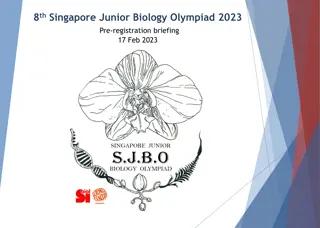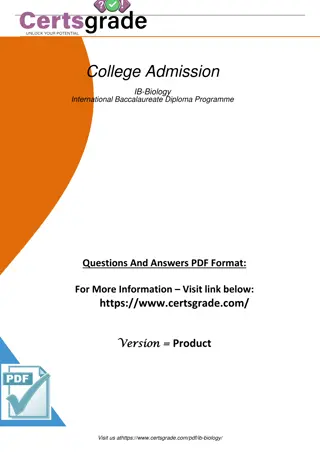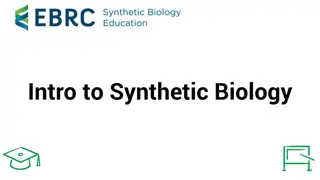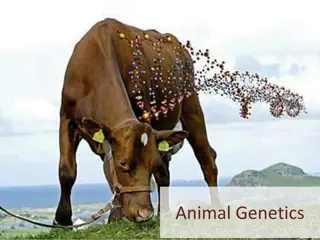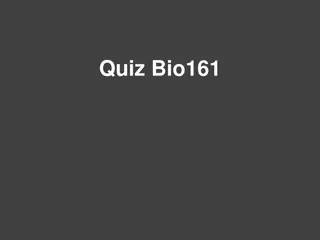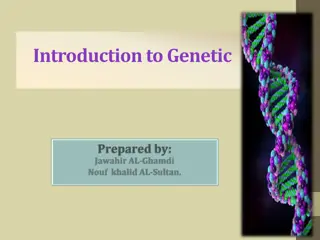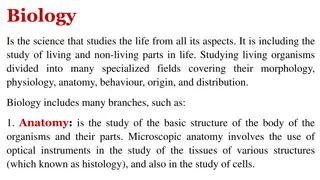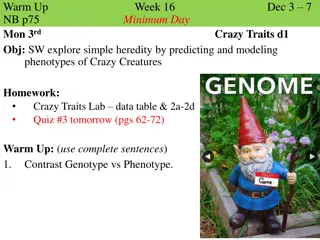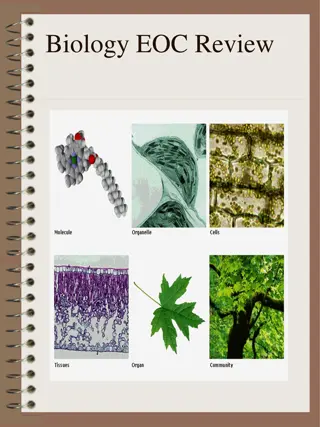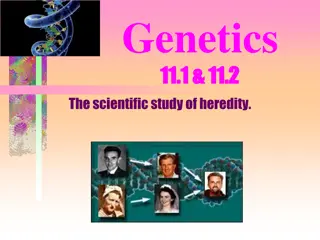
Teachable Unit: Heredity Module in Biology Course
This educational module focuses on heredity, exploring gene inheritance, genetic disorders, and sex-linked traits within an introductory biology framework. Students learn to comprehend genetic concepts, predict outcomes, and analyze pedigrees. Prior knowledge of genotype-phenotype relationships is assumed, with a focus on single-trait crosses. The module aims to enhance understanding of gene-chromosome connections and provide insights into genetic inheritance.
Download Presentation

Please find below an Image/Link to download the presentation.
The content on the website is provided AS IS for your information and personal use only. It may not be sold, licensed, or shared on other websites without obtaining consent from the author. If you encounter any issues during the download, it is possible that the publisher has removed the file from their server.
You are allowed to download the files provided on this website for personal or commercial use, subject to the condition that they are used lawfully. All files are the property of their respective owners.
The content on the website is provided AS IS for your information and personal use only. It may not be sold, licensed, or shared on other websites without obtaining consent from the author.
E N D
Presentation Transcript
HEREDITYYYYYYY 2015 July 17 c/o: Aaron, Darcie, Diana, Geeta, Kristin, Rou-Jia
Introduction Our teachable unit : Heredity module Embedded within Introductory Biology course Prerequisites: None (high school level biology) Student population: First-year students, both majors or non-majors Rou-Jia
Introduction Our teachable unit : Heredity module Embedded within Introductory Biology course Prerequisites: None (high school level biology) Student population: First-year students, both majors or non-majors Our teachable tidbit : Sex-linked traits Rou-Jia
Introduction Our teachable unit : Heredity module Goals Our teachable tidbit : Sex-linked traits Objectives Rou-Jia
Introduction Our teachable unit : Heredity module Goals 1) Understand how genes and chromosomes relate to traits 2) Appreciate how traits are passed on from parents to offspring 3) Comprehend the inheritance of genetic disorders Our teachable tidbit : Sex-linked traits Objectives Rou-Jia
Introduction Our teachable unit : Heredity module Goals 1) Understand how genes and chromosomes relate to traits 2) Appreciate how traits are passed on from parents to offspring 3) Comprehend the inheritance of genetic disorders Our teachable tidbit : Sex-linked traits Objectives 1) Be able to diagram a single-trait sex-linked cross and predict genotypic/phenotypic percentages. 2) Determine if a genetic disorder is sex-linked by analyzing a pedigree. 3) Distinguish between dominant versus recessive genetic disorders. Rou-Jia
Prior knowledge From the previous class: Concepts/definitions students should be familiar with: heterozygous vs homozygous recessive vs dominant genotype vs phenotype carrier autosomal single-trait crosses Punnett squares Aaron
Sex-linked traits What is a sex-linked trait?!? Aaron
Sex-linked traits What is a sex-linked trait?!? Definition: A trait whose gene is located on a sex chromosome (almost always the X-chromosome). Aaron
Sex-linked traits What is a sex-linked trait?!? Definition: A trait whose gene is located on a sex chromosome (almost always the X-chromosome). Why is this important/why should we care? Aaron
Sex-linked traits What is a sex-linked trait?!? Definition: A trait whose gene is located on a sex chromosome (almost always the X-chromosome). Why is this important/why should we care? Common sex-linked diseases: Colorblindness Hemophilia Duchenne muscular dystrophy Implications for genetic counseling Aaron
Clicker Question! Which of the following genotypes is representative of an affected female for hemophilia, an X-linked recessive disorder? A. AA B. XaY C. aa D. XaXa E. XAXa Aaron
Clicker Question! Which of the following genotypes is representative of an affected female for hemophilia, an X-linked recessive disorder? A. AA B. XaY C. aa D. XaXa E. XAXa Aaron
Clicker Question round 2 Which of the following genotypes is representative of a carrier for hemophilia, an X-linked recessive disorder? A. AA B. XaY C. aa D. XaXa E. XAXa Aaron
Clicker Question round 2 Which of the following genotypes is representative of a carrier for hemophilia, an X-linked recessive disorder? A. AA B. XaY C. aa D. XaXa E. XAXa Aaron
Clicker Question round 2 Which of the following genotypes is representative of a carrier for hemophilia, an X-linked recessive disorder? A. AA B. XaY C. aa D. XaXa E. XAXa Do you think males can be carriers for sex-linked disorders? Why? Aaron
Pedigrees! What is a pedigree? A visual representation of family history for a trait. Standard notation for analyzing/constructing a pedigree: Diana
Pedigrees! What is a pedigree? A visual representation of family history for a trait. Standard notation for analyzing/constructing a pedigree: Diana
Pedigrees! What is a pedigree? A visual representation of family history for a trait. Standard notation for analyzing/constructing a pedigree: Female Male Diana
Pedigrees! What is a pedigree? A visual representation of family history for a trait. Standard notation for analyzing/constructing a pedigree: Mating Line Female Male Descent Line Diana
Pedigrees! What is a pedigree? A visual representation of family history for a trait. Standard notation for analyzing/constructing a pedigree: Mating Line Generation designation: I, II, III, IV Individual designation: 1, 2, 3, 4 Female Male I.1 I.2 Descent Line II.1 II.2 Diana
Pedigrees! What is a pedigree? A visual representation of family history for a trait. Standard notation for analyzing/constructing a pedigree: Mating Line Generation designation: I, II, III, IV Individual designation: 1, 2, 3, 4 Female Male I.1 I.2 Descent Line Trait Absent Trait Present Phenotype designation II.1 II.2 Diana
Pedigree activity Assume the pedigree below displays information about a recessive, X-linked disorder. Work with a partner to fill in the phenotypes for generation I individuals and genotypes and phenotypes for generation II individuals. XaXa XAY XAXA XaY Working together in pairs, fill out the provided worksheet Kristin
Pedigrees! What is a pedigree? A visual representation of family history for a trait. Standard notation for analyzing/constructing a pedigree: Mating Line Generation designation: I, II, III, IV Individual designation: 1, 2, 3, 4 Female Male I.1 I.2 Descent Line Trait Absent Trait Present Phenotype designation II.1 II.2 Kristin
Pedigree activity Assume the pedigree below displays information about a recessive, X-linked disorder. Work with a partner to fill in the phenotypes for generation I individuals and genotypes and phenotypes for generation II individuals. XaXa XAY XAXA XaY Working together in pairs, fill out the provided worksheet Kristin
Pedigree activity Assume the pedigree below displays information about a recessive, X-linked disorder. Work with a partner to fill in the phenotypes for generation I individuals and genotypes and phenotypes for generation II individuals. XaXa XAY XAXA XaY XAXa XaY XAXa Working together in pairs, fill out the provided worksheet Kristin
What about Generation III? If II.2 and II.3 have children: 1) Is it possible for them to show the trait? 2) If so, can both boys and/or girls show the trait? XaXa XAY XAXA XaY XAXa XaY XAXa Kristin
Mating activity for Generation III! Instructions You have each received a pair of cards representing alleles for the proud parents-to-be from Generation II. Now: 1) Find a partner with the opposite color cards. 2) Hold your cards behind your back, one in each hand. 3) Have your partner randomly select one of your hands. 4) Place your selected card on the table. 5) Repeat 3-4 with your partner s cards. 6) Now define your offspring s genotype. 7) ONE OF YOU report your offspring by clicking the appropriate choice. Geeta
Mating activity for Generation III! Click in the resulting genotype of your offspring! A. XaXa B. XAXa C. XaY D. XAY XaXa XAY XAXA XaY XAXa XaY XAXa Geeta
Main takeways from today You should be able to define what a sex-linked trait is and understand their heredity. You should be able to analyze a pedigree and predict the phenotypes and genotypes of the offspring. Darcie
Summative Assessments Darcie
1) Colorblindness is an X-linked recessive trait. If a father who is XRY has children with an XrXr mother, what is the probability (percentage) that a daughter born to the couple would be colorblind? a. 0% b. 25% c. 50% d. 75% e. 100% Darcie
1) Analyze the following pedigree for the pattern of inheritance, and answer the following questions. Assume that individuals II-1 and II-4 do not have the detrimental allele. Is this a dominant or recessive trait? Additionally, circle the couple that best supports your reasoning and explain. Is this a sex-linked trait? Why or why not? Darcie What is the genotype of individual I-1? Explain your reasoning.

